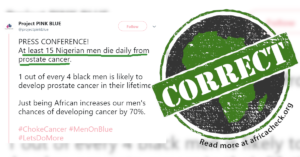New data supports claim that 15 men die every day from prostate cancer in Nigeria
This article is more than 4 years old
At least 15 Nigerian men die daily from prostate cancer. That’s according to a May 2019 tweet by Project Pink Blue, an Abuja-based cancer-fighting organisation.
The organisation is calling for mandatory annual screening for men over 40 and compulsory medical insurance, among other measures.
Prostate cancer starts in the prostate, a reproductive gland only men have.
A Twitter user questioned the statistic.
It came from the 2018 Global Cancer Observatory published by the International Agency for Research on Cancer (IARC), Project Pink Blue spokesperson Hero Godspower told Africa Check.
The observatory lists the five most common cancers in Nigeria. They are breast cancer, cancer of the cervix uteri, prostate cancer, liver cancer and non-Hodgkin lymphoma.
In 2018 Africa Check looked at a similar claim and found that the best estimate for prostate cancer deaths in Nigeria was 9,628, or an average of 26 deaths a day. This data was from the Global Cancer Observatory for 2012.
The IARC estimated these deaths from information in three Nigerian registries that are members of the African Cancer Registry Network. These are Abuja, Ibadan and Calabar.
It also used a model based on survival data to calculate the number of deaths each year.
The 2018 Global Cancer Observatory is the most recent, published in March 2019. It shows Nigeria now has a best estimate of 5,806 prostate cancer deaths, or 16 a day.
The IARC also estimates that 70,327 Nigerians died from all types of cancer in 2018.

How did it calculate this? The agency used models derived from national incidence estimates and compared cancer registry data from neighbouring countries.
This is because there “is very sparse information on cancer in Nigeria”, Jacques Ferlay, an informatics officer at the IARC’s cancer surveillance unit told Africa Check.
“The very little information we have at the IARC comes from three population-based cancer registries covering 2% of the Nigerian population.”
The different data sources and methods used explain the difference between the 2012 and 2018 estimates, Ferlay said.
The organisation is calling for mandatory annual screening for men over 40 and compulsory medical insurance, among other measures.
Prostate cancer starts in the prostate, a reproductive gland only men have.
A Twitter user questioned the statistic.
It came from the 2018 Global Cancer Observatory published by the International Agency for Research on Cancer (IARC), Project Pink Blue spokesperson Hero Godspower told Africa Check.
The observatory lists the five most common cancers in Nigeria. They are breast cancer, cancer of the cervix uteri, prostate cancer, liver cancer and non-Hodgkin lymphoma.
Prostate cancer deaths at 26 a day in 2012
In 2018 Africa Check looked at a similar claim and found that the best estimate for prostate cancer deaths in Nigeria was 9,628, or an average of 26 deaths a day. This data was from the Global Cancer Observatory for 2012.
The IARC estimated these deaths from information in three Nigerian registries that are members of the African Cancer Registry Network. These are Abuja, Ibadan and Calabar.
It also used a model based on survival data to calculate the number of deaths each year.
The 2018 Global Cancer Observatory is the most recent, published in March 2019. It shows Nigeria now has a best estimate of 5,806 prostate cancer deaths, or 16 a day.
The IARC also estimates that 70,327 Nigerians died from all types of cancer in 2018.

‘Very little information’
How did it calculate this? The agency used models derived from national incidence estimates and compared cancer registry data from neighbouring countries.
This is because there “is very sparse information on cancer in Nigeria”, Jacques Ferlay, an informatics officer at the IARC’s cancer surveillance unit told Africa Check.
“The very little information we have at the IARC comes from three population-based cancer registries covering 2% of the Nigerian population.”
The different data sources and methods used explain the difference between the 2012 and 2018 estimates, Ferlay said.

Add new comment